- Home
- Robert A. Heinlein
Grumbles From the Grave
Grumbles From the Grave Read online
GRUMBLES FROM THE GRAVE
By Robert A. Heinlein
GRUMBLES FROM THE GRAVE
Robert A. Heinlein
Edited by Virginia Heinlein
Copyright © 1989 by the Robert A. and Virginia Heinlein Trust, UDT 20 June 1983
All rights reserved under International and Pan-American Copyright Conventions. Originally published in the United States by Ballantine Books, a division of Random House, Inc., New York, and simultaneously in Canada by Random House of Canada Limited, Toronto.
Grateful acknowledgment is made to the following for permission to reprint the following material: Davis Publications, Inc.: Excerpts from ten letters written by John W. Campbell as editor of Astounding Science Fiction. Copyright © 1989 by Davis Publications, Inc. Putnam Publishing Group: Excerpt from the original manuscript of Podkayne of Mars by Robert A. Heinlein. Copyright © 1963 by Robert A. Heinlein. Reprinted by permission of the Putnam Publishing Group.All rights reserved, including the right to reproduce this book or portions thereof in any form.
A Baen EBook
Baen Publishing Enterprises
P.O. Box 1403
Riverdale, NY 10471
www.baen.com
ISBN-10: t/k
ISBN-13: t/k
First Ebook printing, t/k
Transcriber's Note: The photo credits at the end of the book used page numbers to reference the illustrations. Since Ebooks do not have pages, those page numbers have been included as parenthesized captions for each illustration.
Coming of Age in a Dangerous Galaxy
by Tony Daniel
Robert Heinlein did not burst forth from the head of Zeus a science fiction writer. After growing up in Kansas City, Missouri, Heinlein followed his brother’s pathway and got an appointment to the U.S. Naval Academy at Annapolis where he graduated twentieth in a class of 243. After serving as a gunnery officer on the first U.S. aircraft carrier, he came down with tuberculosis and was cashiered from active duty by the navy. Thrown out of a career at twenty-seven, a career to which he’d expected to devote his life, and sick with tuberculosis, the young Heinlein spent the next five years reinventing himself through trial and error.
What worked was science fiction.
The SF tale itself was at a critical juncture in the late thirties, and World War II would shortly push it over the edge as millions of men and women returned home matured far beyond their years by what they had seen and done. Would science fiction grow up? Would SF stories be about real people facing problems created by believable extrapolation, or would gee-whizz wonder tales staffed by stereotypes continue to rule?
Heinlein was already there with the answer. His stories would be about ordinary men and women who did not set out to save the world, but who merely wanted to live their lives, get ahead without cheating their morals, and make their existence somehow meaningful. Sometimes they saved the world in the process, but this sort of megalomania was never their intent.
John W. Campbell’s Astounding magazine was publishing this new, grittier material, with muscular prose and an adult attitude. Heinlein quickly became Campbell’s go-to writer for a decade.
As the Forties ran down, Heinlein cracked the slicks, well-regarded magazines such as the Saturday Evening Post and others, and was asked to produce a series of juveniles−what we would now call young adult or YA novels−by the upscale publishing house of Charles Scribner’s Sons. Over the next decade, he tried to write one juvie a year along with one adult SF novel, and mostly succeeded in doing so.
The juveniles became breakout bestsellers, were snatched up by an expanding system of local libraries, and created a decent living for Heinlein. Heinlein ultimately produced thirteen of them.
The juvies got better and better with each volume, culminating in the exciting, deeply-moving Citizen of the Galaxy, with its haunting echo of Kipling’s Kim,and finally with the zenith of the series, a masterpiece of American fiction, Have Space Suit−Will Travel.
Citizen of the Galaxy and Have Space Suit−Will Travel are the last two of the Scribner’s juveniles, but not the last juvenile. Heinlein considered Starship Troopers, which was rejected by Scribner’s in the early version of a politically-correct editorial snit by Charles Scribner himself (and immediately snatched up by rival Putnam), the final book in his young adult series. But, as Heinlein also notes, Starship Troopers is a novel oriented toward adults that just happens to have a youthful protagonist.
Citizen of the Galaxy is the classic tale of the young person who climbs from a lowly state (in this case, abject slavery) to competence and finally to a position where he’s able to reclaim his lost heritage. He’s helped along the way by a series of complex, compelling and sympathetic wise figures. These adults have adapted to a baroque and corrupted galactic civilization, but have managed to retain their own integrity and continue to fight for the right. They all serve as models for Thorby, who is forced by circumstances to come of age immediately−or die a poor, bewildered child. Adapt he does, and off we go on a compelling adventure full of Heinlein’s usual attention to detail and drama until Thorby eventually becomes a figure of wisdom himself.
Have Space Suit−Will Travel is, without a doubt, the jewel in the crown of the juveniles. In many ways, it is science fiction’s Adventures of Huckleberry Finn. The parallel between Kip and Huck (or, depending on circumstances, Kip and wily-but-civilized Tom Sawyer) is no accident. Mark Twain was Heinlein’s favorite writer. Heinlein was a great collector of Twain’s work, as well, and had everything, even obscure seldom- or never-reprinted pieces by Twain, on his bookshelves.
In Space Suit, young Kip wins a decrepit space suit as a bait-and-switch prize in a cheesy contest. But if space is as free and wondrous as Huck’s Mississippi river, it also proves to be just as fraught with dangers and decisions. And in an ending that prefigures the ground-breaking, game-changing adult science fiction novels Heinlein was shortly to write, Kip must save humanity while somehow remaining true to himself. For, of course, it is the average guy who never gives up on his dream, no matter how much hard-scrabbling and scheming its fulfillment requires, who is the real Heinleinian hero.
As a matter of fact, says Kip, the universe, its powerful alien overlords, and existence itself needs to respect humans and their crazy drive and dreams or things will go badly for it. “All right, take away our star−You will if you can, and I guess you can. Go ahead! We’ll make a star! Then, someday, we’ll come back and we’ll hunt you down. All of you!”
The juveniles were wildly successful and influential. The generation who first read them became the scientists and engineers who put humans on the Moon and who laid the foundations for the coming information age. The books have stood the test of time and found future generations. This author was profoundly influenced as a teen by the tragic pathos of separated twins in Time for the Stars, the valor-laden ethos of Starship Troopers, and the complex philosophical satire of Stranger in a Strange Land (a lot of which yours truly barely grokked at the time−but so what? The story rocked).
The success of the juvies and their human-centered worldview produced a critical backlash against all of Heinlein’s work that often verged on incoherent rage.
The first objection is to Heinlein’s politics, and is usually founded on a simplistic reading of Starship Troopers or The Moon is a Harsh Mistress by those who have had one too many doctrinaire sociology classes in the process of receiving a second-rate education. The fact is, Heinlein’s novels contain practically everything politically, from decadent oligarchy to fundamentalist totalitarian hells, to control-ridden socialist states, to libertarian anarchies. Furthermore, while Heinlein is clearly on the side of the angels o
f democracy, he’s never doctrinaire about anything political. On the contrary, his usual point is that any system short of outright dictatorship can be made to work with competent and honest administration.
Politics, for Heinlein, is always practical, seat-of-the-pants stuff (see his insightful and amusing primer on local politicking, Take Back Your Government, for his nuts-and-bolts approach). He’s an empiricist when it comes to justice and morality. His critics, on the other hand, tend to be rationalists with preconceived rubrics that they are certain reality had better mold itself to if reality knows what’s good for it.
Heinlein finds such attitudes juvenile in the worse sense−and dangerous for the holder’s continued survival chances. He makes this point time and again in story form. Educate yourself, learn from experience, do whatever it takes to adapt, abandon useless assumption. Your purpose has to be individual survival, for humanity comes only in the unit of the individual. Anything else destroys what makes us unique.
You−and not some nebulous collective consciousness or high priesthood−are the human race’s flawed, imperfect protagonist. The story that matters is your story, our story, not that of some king, nation-state, or intergalactic uber-government. Those entities are merely background characters for the individual action that matters. And whatever your circumstances, it’s your duty to answer the call to heroism and hard striving that being born a person demands.
The backlash of the self-appointed tastemakers that crested with the appearance of Starship Troopers was not a surprise to Heinlein. He’d already had a great deal of practice in staying the course when writing the twelve juvies that preceded it.
All but the last of Heinlein’s young adult novels were overseen by his fretful editor at Scribner’s, Alice Dalgliesh. At least to Heinlein’s sensibilities, Dalgliesh combined in the most annoying form imaginable the fashionable leftism that infected American publishing starting in the 1930s with the instincts of a small-town librarian on a fundamentalist book-banning kick. Both of these types are particular bete noirs throughout Heinlein’s fiction−and here was an editor, someone with power over his paycheck, who combined both, in his real life.
Heinlein was particularly irked by Dalgliesh’s Freudian interpretation of nearly every cultural idea he put into a story. As he put it, she seemed to believe that “[s]cience fiction consists of stories about the wonderful machines of the future” and anything else was a sign an author was working out his inner mother complex and simultaneously scrawling depraved sexual notions onto the blank slates his young readers presumably had for minds.
But how did this odd juxtaposition of writer and editor produce some of the best literature of the twentieth century? Because, like the writer of sonnets who makes use of a constricted form for the beautiful effect it can produce, Heinlein forced himself to write−and to write well−within Dalgliesh’s dogmatic confines. If he couldn’t break the rules, he decided to transcend them.
The results? Young adult novels that adults can read with pleasure and without having to make allowances. Books filled with young characters getting it on, but getting it on with their environment, with the business of staying alive, with the generation of new, cool ideas. Love, romance, sex is all part of life, part of the process of survival. All of the relationships that appear in the juvies are remarkably mature and adult. Heinlein simply didn’t have that sometime teenage fascination with the hidden or creepy when it came to sex. But with Dalgliesh’s pop Freudian analysis of everything in mind, he had to think about every word he wrote in such terms−allegedly to keep that kind of stuff out. At the same time, Heinlein absolutely refused to write down to an audience, even if the audience was adolescent boys (and many, many girls, as later became apparent).
So we get remarkable friendships, such as that between Kip and the precocious PeeWee in Have Space Suit−Will Travel whose quirky and clever goodness inspire Kip to become a hero he could never have imagined, much less have accomplished, without her. With Heinlein’s older protagonists, romantic relationships become very real, more akin to marriage than to a simple hook-up. Most importantly, they are high stakes, and involve the problem of how to, say, work to bring down a totalitarian state or deal with alien abduction while somehow keeping friendship and love alive.
All of Heinlein’s heroines, like his heroes (although his male characters never seems to be an issue with Heinlein gender critics), are entertaining and desirable because of who they are rather than what they are. This applies even more so outside the juvies. Take Methuselah’s Children, where Mary Sperling’s stark choice has nothing and everything to do with being a woman. As her genetically-extended extra days of life run out, she has to decide between the true love she’s finally found and a version of immortality that may destroy her as an individual.
The closest Heinlein comes to portraying a total naïf and objectifier of women is John Lyle in Revolt in 2100, a collection of interconnected novellas first published in Astounding. These were the stories that made Heinlein’s name. Yet even though quixotic, unrealistic romantic passion triggers Lyle’s revolt against his fundamentalist masters, as he comes to maturity in the trenches such notions give way to longing for a lasting relationship with a battle-tested soul mate who is as strong-willed and individualistic as he is.
In company with Heinlein’s political critics, the gender critics always seem to make the categorical mistake of taking this or that character’s pronouncement inside a Heinlein tale for Heinlein’s own attitude. It’s all nonsense. One look at Heinlein’s relationship with his wife Virginia in Grumbles from the Grave and Tramp Royale, and it becomes obvious that Heinlein’s career was a joint venture and a shared journey with someone he considered just as smart and driven as himself−and most definitely somebody he knew from experience was a better linguist, mathematician and life-organizer.
As Damon Knight describes her in his introduction to Heinlein’s The Past Through Tomorrow, Virginia Heinlein “is a chemist, biochemist, aviation test engineer, experimental horticulturalist; she earned varsity letters at N.Y.U. in swimming, diving, basketball and field hockey, and became a competitive figure skater after graduation; she speaks seven languages so far, and is starting on an eighth.”
There is one book in which Virginia and Heinlein himself are the main characters, and that is his travelogue of a year spent traveling around the world, Tramp Royale. One begins the book expecting to enjoy a few wacky and now retro descriptions of foreign locales and some ironic nostalgia for the past. What one receives instead is wave after wave of frission of recognition. Apart from the prices, the world hasn’t changed much. And after encountering a few of Heinlein’s excellent recreation of conversations with foreigners and his observations of them, it all becomes eerily familiar. The anti-Americanism he encounters is ludicrous and based upon as much ignorance as it is today.
In one telling passage, Heinlein describes how he spent a great deal of time explaining that Senator Joseph McCarthy, then in the news, was not about to take over the reins of power in America and start a nuclear war with Russia. Neither was America spinning into totalitarianism anytime soon. And since none of this was true, why wasn’t McCarthy taken out by the government and shot? Heinlein, who had been fairly left-leaning in his younger days and had campaigned for Sinclair Lewis’s run for the governorship of California, was as annoyed at McCarthy’s idiocy as anyone, but knew he was in no danger from it.
“I am not a constituent or admirer of the senator, but I found myself repeatedly in the odd position of trying to explain what he was doing, why it was legal in a free country for him to do it, and how it was impossible in a free country for a congressional investigation to cause a ‘reign of terror’ in 160,000,000 people…In the communist half of the world a man such as McCarthy would really have power. He would be a ‘people’s judge’ and his victims would never live to complain.”
Heinlein’s own observation of the vast array of countries he and Virginia visited is exquisite. This is travel writing at i
ts best, and was years ahead of its time in judgment and outlook. As with many things Heinlein, this is one that has come back around into fashion and seems utterly contemporary. Furthermore, Heinlein’s advice on travel etiquette is timeless and useful and, at times, highly amusing.
Finally, Grumbles from the Grave is a kind of writer’s autobiography in letters. Collected and edited by Virginia Heinlein after Heinlein’s death, these are largely Heinlein’s letters first to John W. Campbell and then to his agent and long-time friend, Lurton Blassingame. If you were ever searching for the lost book Heinlein ought to have produced on the art of writing, you’ll find it here. Wonderful discussions of methods, overcoming blocks, writing on spec and to order can be found throughout, as well as expert (and still pertinent) commentary on the business of writing.

 Job: A Comedy of Justice
Job: A Comedy of Justice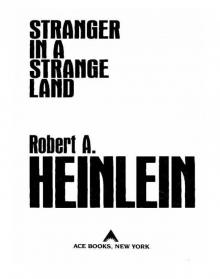 Stranger in a Strange Land
Stranger in a Strange Land The Worlds Of Robert A Heinlein
The Worlds Of Robert A Heinlein The Roads Must Roll
The Roads Must Roll Starship Troopers
Starship Troopers Farmer in the Sky
Farmer in the Sky The Past Through Tomorrow
The Past Through Tomorrow The Door Into Summer
The Door Into Summer All You Zombies
All You Zombies Friday
Friday Tomorrow, the Stars
Tomorrow, the Stars The Notebooks of Lazarus Long
The Notebooks of Lazarus Long The Moon Is a Harsh Mistress
The Moon Is a Harsh Mistress Beyond This Horizon
Beyond This Horizon Time Enough for Love
Time Enough for Love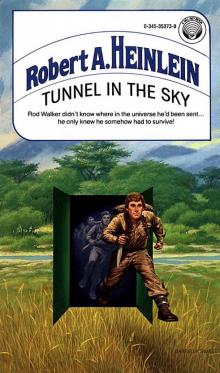 Tunnel in the Sky
Tunnel in the Sky Podkayne of Mars
Podkayne of Mars The Star Beast
The Star Beast The Cat Who Walks Through Walls
The Cat Who Walks Through Walls Grumbles From the Grave
Grumbles From the Grave Time for the Stars
Time for the Stars The Number of the Beast
The Number of the Beast The Unpleasant Profession of Jonathan Hoag
The Unpleasant Profession of Jonathan Hoag Sixth Column
Sixth Column To Sail Beyond the Sunset
To Sail Beyond the Sunset Revolt in 2100
Revolt in 2100 And He Built a Crooked House
And He Built a Crooked House The Pursuit of the Pankera: A Parallel Novel About Parallel Universes
The Pursuit of the Pankera: A Parallel Novel About Parallel Universes Expanded Universe
Expanded Universe Starman Jones
Starman Jones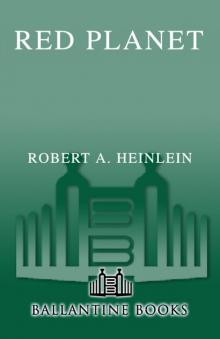 Red Planet
Red Planet Double Star
Double Star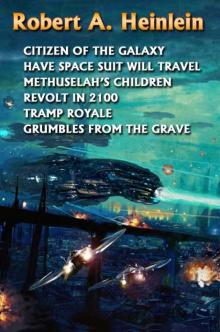 Citizen of the Galaxy
Citizen of the Galaxy Rocket Ship Galileo
Rocket Ship Galileo Glory Road
Glory Road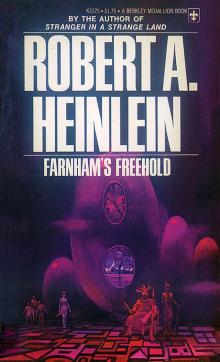 Farnham's Freehold
Farnham's Freehold Space Cadet
Space Cadet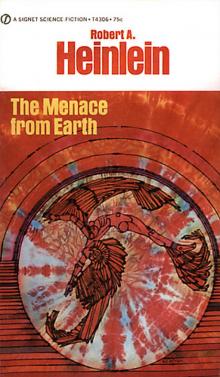 The Menace From Earth ssc
The Menace From Earth ssc Between Planets
Between Planets Methuselah's Children
Methuselah's Children Have Space Suit—Will Travel
Have Space Suit—Will Travel The Rolling Stones
The Rolling Stones Door Into Summer
Door Into Summer The Cat Who Walked Through Walls
The Cat Who Walked Through Walls Magic, Inc
Magic, Inc Off The Main Sequence
Off The Main Sequence Pied Piper
Pied Piper The Unpleasant Profession Of Jonathan Hoag And Other Stories
The Unpleasant Profession Of Jonathan Hoag And Other Stories Variable Star
Variable Star Waldo, and Magic, Inc
Waldo, and Magic, Inc Robert A. Heinlein: In Dialogue With His Century
Robert A. Heinlein: In Dialogue With His Century Waldo
Waldo Bulletin Board
Bulletin Board Job: A Comedy
Job: A Comedy Tramp Royale
Tramp Royale A Tenderfoot in Space
A Tenderfoot in Space For Us, the Living
For Us, the Living Destination Moon
Destination Moon Logic of Empire
Logic of Empire The Fantasies of Robert A. Heinlein
The Fantasies of Robert A. Heinlein The Menace From Earth
The Menace From Earth From the Notebooks Of Lazarus Long
From the Notebooks Of Lazarus Long Have Space Suit - Will Travel
Have Space Suit - Will Travel A Stranger in a Strange Land
A Stranger in a Strange Land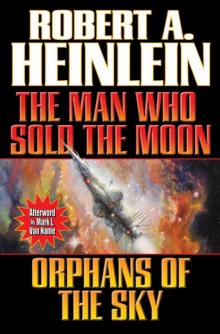 Man Who Sold the Moon / Orphans of the Sky
Man Who Sold the Moon / Orphans of the Sky